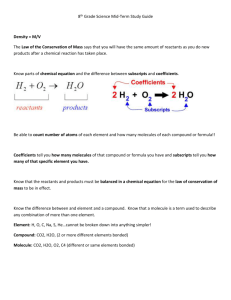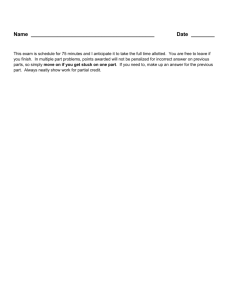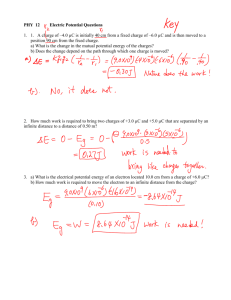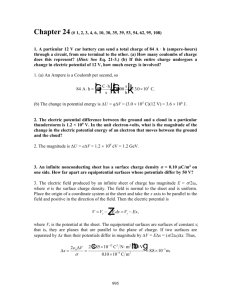Physics 9 Fall 2009 - faculty.ucmerced.edu
advertisement
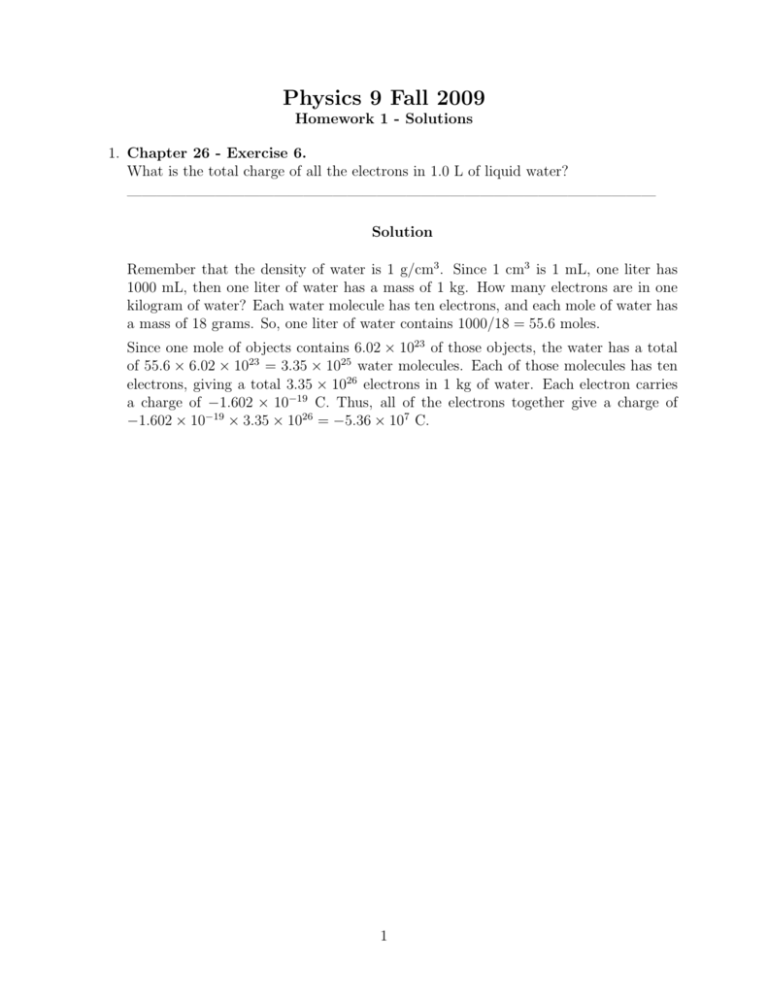
Physics 9 Fall 2009 Homework 1 - Solutions 1. Chapter 26 - Exercise 6. What is the total charge of all the electrons in 1.0 L of liquid water? ———————————————————————————————————— Solution Remember that the density of water is 1 g/cm3 . Since 1 cm3 is 1 mL, one liter has 1000 mL, then one liter of water has a mass of 1 kg. How many electrons are in one kilogram of water? Each water molecule has ten electrons, and each mole of water has a mass of 18 grams. So, one liter of water contains 1000/18 = 55.6 moles. Since one mole of objects contains 6.02 × 1023 of those objects, the water has a total of 55.6 × 6.02 × 1023 = 3.35 × 1025 water molecules. Each of those molecules has ten electrons, giving a total 3.35 × 1026 electrons in 1 kg of water. Each electron carries a charge of −1.602 × 10−19 C. Thus, all of the electrons together give a charge of −1.602 × 10−19 × 3.35 × 1026 = −5.36 × 107 C. 1 2. Chapter 26 - Exercise 13. Two 1.0 kg masses are 1.0 m apart (center to center) on a frictionless table. Each has +10 µC of charge. (a) What is the magnitude of the electric force on one of the masses? (b) What is the initial acceleration of this mass if it is released and allowed to move? ———————————————————————————————————— Solution (a) The force on one of the masses is identical to the force on the other, and is 1 qQ Plugging in the numbers gives F = given by Coulomb’s law, F~ = 4π 2 r̂. 0 r 2 −6 (10×10 ) (9 × 109 ) = 0.90 N. 12 (b) Newton tells us that F = ma, and so a = F/m. Dividing the force we found in part a by the mass of the object gives a = F/m = 0.9/1 = 0.9 m/s2 . 2 3. Chapter 26 - Exercise 21. ~ The electric field at a point in space is E = 200î + 400ĵ N/C. (a) What is the electric force on a proton at this point? Give your answer in component form. (b) What is the electric force on an electron at this point? Give your answer in component form. (c) What is the magnitude of the proton’s acceleration? (d) What is the magnitude of the electron’s acceleration? ———————————————————————————————————— Solution ~ is F~ = q E. ~ The charge on the (a) The electric force on a charge q in an electric fieldE proton is q = +e = 1.602 × 10−19 , and so F~p = e 200î + 400ĵ = 3.2î + 6.4ĵ × 10−17 N. (b) The electron carries an equal, but opposite, charge as does the proton. This just ~ changes the sign of the force that we found in part a, giving Fe = − 3.2î + 6.4ĵ × 10−17 N. √ F 2 +F 2 x y . The proton has a mass (c) The magnitude of the acceleration is a√= F/m = m Fp 3.22 +6.42 ×10−17 −27 = 4.28 × 1010 m/s2 . of 1.67 × 10 kg. Thus, ap = mp = 1.67×10−27 (d) Here we just divide by the mass of the electron. Since it’s lighter, we expect the √ Fe 3.22 +6.42 ×10−17 electron to have a bigger acceleration. ae = me = = 7.85 × 1013 9.11×10−31 m/s2 . The electron does have a bigger acceleration, as expected. 3 4. Chapter 26 - Exercise 25. What are the strength and direction of an electric field that will balance the weight of a 1.0 g plastic sphere that has been charged to -3.0 nC? ———————————————————————————————————— Solution Because the sphere is charged, it experiences an electric force, F~E , when placed in an electric field. There is also a gravitational force FG acting on the sphere. When these forces are balanced, then FE = FG . The electric force is FE = qE, while FG = mg, and so mg . E= q Since the charge is negative, we see that the electric field has to point down so that the charge is repelled up. The magnitude of the force is E= 10−3 × 9.8 mg = = 3.3 × 106 N/C. q 3 × 10−9 As we said, the direction is down, so we can write the full electric field as ~ = −3.3 × 106 ĵ N/C, E where ĵ points along the vertical direction. 4 5. Chapter 26 - Problem 34. The nucleus of a 125 Xe atom (an isotope of the element xenon with mass 125 u) is 6.0 fm in diameter. It has 54 protons and charge q = 54e. (a) What is the electric force on a proton 2.0 fm from the surface of the nucleus? (b) What is the electric force on an electron at this point? Give your answer in component form. (c) What is the proton’s acceleration? Hint: Treat the spherical nucleus as a point charge. ———————————————————————————————————— Solution 1 qQ (a) The electric force is given by Coulomb’s law, F = 4π 2 . What’s the distance, 0 r r? The proton is 2.0 fm from the surface, so r = 6/2 + 2 = 5 fm. Thus, 2 −19 1 qQ ) 9 (54) (1.602 × 10 = 500 N. F = = 9 × 10 2 2 −15 4π0 r (5 × 10 ) (b) The proton’s acceleration is just a = F/mp , so a= F 500 = = 3.00 × 1029 m/s2 . mp 1.67 × 10−27 This is a huge acceleration! 5 6. Chapter 26 - Problem 38. What is the force F~ on the 1.0 nC charge in the figure? Give your answer as a magnitude and direction. ———————————————————————————————————— Solution The net force on the 1.0 nC charge is the sum of the forces from each charge, F~tot = F~2.0 + F~−2.0 . The force from the positive charge is F~2.0 = = 9 = (9 × 10 ) = (1×10−9 )(2×10−9 ) 1 4π0 1 4π h 0 qQ r̂ r2 qQ ~r r3 ◦ ◦ 0.01 cos (60 ) î + .01 sin (60 ) ĵ √ 0.9 × 10−4 î + 3ĵ N. i (0.01)3 The force from the negative charge is F~−2.0 = 1 qQ r̂ 4π0 r2 h i −9 −9 1×10 −2×10 ( )( ) ◦ ◦ −0.01 cos (60 ) î + .01 sin (60 ) ĵ = (9 × 109 ) (0.01)3 √ −4 î − 3ĵ N. = 0.9 × 10 √ √ So, the net force is F~tot = F~2.0 + F~−2.0 = 0.9 × 10−4 î + 3ĵ + 0.9 × 10−4 î − 3ĵ N, or F~tot = 1.8 × 10−4 î N; the force is entirely in the x−direction. 6 7. Chapter 26 - Problem 54. Suppose the magnitude of the proton charge differs from the magnitude of the electron charge by a mere 1 part in 109 . (a) What would be the force between two 2.0-mm-diameter copper spheres 1.0 cm apart? Assume that each copper atom has an equal number of electrons and protons. (b) Would this amount of force be detectable? What can you conclude from the fact that no such forces are observed? ———————————————————————————————————— Solution (a) For this problem we need to look up lots of properties of copper. The density of copper is ρ = 8920 kg/m3 . So, the spheres have a mass of m = ρV = ρ 34 πr3 = 3 (8920) 43 π (10−3 ) = 3.736 × 10−5 kg. Copper also has a molar mass of 63.5 g/mol, and so the spheres contain 0.03736/63.5 = 5.884 × 10−4 moles. This means that they have a total of 5.884 × 10−4 × 6.02 × 1023 = 5.542 × 1020 copper atoms. There are 29 electrons per atom, so the spheres have a total of 29 × 5.542 × 1020 = 1.607 × 1022 electrons. Thus, the total positive charge in each sphere is 1.607 × 1022 × 1.602 × 10−19 = 2575 C. If the electrons had a difference in charge of 10−9 , then it would give each sphere a net charge of 10−9 × 2575 = 2.575 × 10−6 C. From Coulomb’s law, the spheres would have a net force 2 F =k (2.575 × 10−6 ) Q2 9 = 9 × 10 × ≈ 600 N r2 (10−2 )2 (b) This is an easily measurable force! Since we don’t see these forces, this allows us to put limits on the difference in charge between the electron and proton. 7 8. Chapter 26 - Problem 55. In a simple model of the hydrogen atom, the electron moves in a circular orbit of radius 0.053 nm around a stationary proton. How many revolutions per second does the electron make? ———————————————————————————————————— Solution The electric force holds the electron to the proton. Since it’s moving in a circle, there is also a centripetal force. The two forces are equal in magnitude, keeping the circular mv 2 1 e2 = Fcent . Now, we can write v = rω, where ω is orbit stable. So, Felec = 4π 2 = r 0 r the angular frequency. The ordinary frequency is f = ω/2π. Thus, we can solve for the frequency to find mv 2 m 1 e2 = = (rω)2 = mrω 2 . 2 4π0 r r r Thus, ω 2 = 1 e2 , 4π0 mr3 or since ω = 2πf , 1 f= 2π s 1 e2 . 4π0 mr3 Plugging in the numbers gives s s 2 1 1 1 e (1.602 × 10−19 )2 9 = = 6.65×1015 rev/sec. f= (9 × 10 ) 2π 4π0 mr3 2π 9.11 × 10−31 (0.053 × 10−9 ) 8 9. Chapter 26 - Problem 75. The identical small spheres shown in the figure are charged to +100 nC and -100 nC. They hang as shown in a 100,000 N/C electric field. What is the mass of each sphere? ———————————————————————————————————— Solution The net force on the -100 nC charge is the sum of the forces from the positive charge, the electric field, and gravity! The freebody diagram for the negative charge is seen in the figure. Writing down the force equations gives P ◦ P Fx = FE − Fe − T◦ cos (80 ) = 0 Fy = T sin (80 ) − FG = 0. Solving for the tension in the Fy equation gives , where we set FG = mg. Plugging this T = sinmg 80◦ result back into the Fx equation gives FE − Fe = mg . tan 80◦ Now, FE = qE, while Fe = 1 qQ . 4π0 r2 Solving for m then gives q tan 80◦ m= g E− 1 Q 4π0 r2 . From the geometry of the setup, the distance between the charges r = 2L sin 10◦ , where L = 50 cm is the length of the string. Plugging in all the numbers gives −9 1 Q 100 × 10−9 tan 80◦ q tan 80◦ 5 9 100 × 10 m= E− = 10 − 9 × 10 . g 4π0 r2 9.8 sin2 10◦ Evaluating the numbers we find m = 4.1 grams. 9 10. Chapter 26 - Problem 77. In Section 26.3 we claimed that a charged object exerts a net attractive force on an electric dipole. Let’s investigate this. The figure to the left shows a permanent electric dipole consisting of charges +q and −q separated by the fixed distance s. Charge +Q is distance r from the center of the dipole. We’ll assume, as is usually the case in practice, that s r. (a) Write an expression for the net force exerted on the dipole by the by charge +Q. (b) Is this force toward +Q or away from +Q? Explain. (c) Use the binomial approximation (1 + x)−n ≈ 1 − nx if x 1 to show that your expression from part a can be written Fnet = 2KqQs/r3 . (d) How can an electric force have an inverse-cube dependence? Doesn’t Coulomb’s law say that the electric force depends on the inverse square of the distance? Explain. ———————————————————————————————————— Solution (a) The net force from the charge comes from both the positive and the negative charges in the dipole. From the figure, the distance from q to Q is r + s/2, and so the force between these two charges is F~pos = −k Qq î, (r + s/2)2 where the force is negative because the two positive charges repel each other, pushing the dipole away. Similarly, since the negative charge in the dipole is a distance r − s/2 away from Q, and is attractive, the force on −q is F~neg = k Qq î. (r − s/2)2 Thus, the net force is F~pos + F~neg , or 1 1 F~ = kQq − î. (r − s/2)2 (r + s/2)2 (b) Because r − s/2 < r + s/2, the first term is bigger, and so the force is to the right – it’s an attractive force. 10 (c) Using the binomial expansion, (1 + x)−n ≈ 1 − nx, we can rewrite 1 1 1 1 1 = − 2 − 2 2 2 2 r (r−s/2) (r+s/2) (1−s/2r) (1+s/2r) 1 s ≈ 1 + − 1 + 2s r2 r 2s = . r3 So, this means that F~ ≈ 2kQqs î, r3 and is attractive. (d) Coulomb’s law applies between point charges. This situation is different – we have entended charge distributions. The negative charge is partially screened by the positive charge in the dipole. So, the force isn’t as strong. The force drops to zero because the dipole looks neutral at large distances; the two charges nearly cancel each other out. 11
